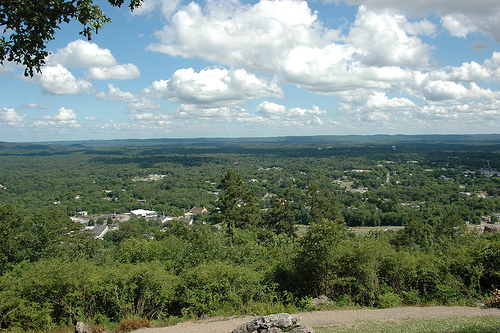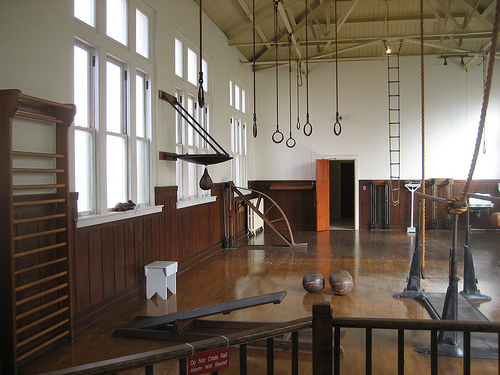


Location: Hot Springs, AR Map
Area: 5,550 acres (22.46 km²)
Hot Springs National Park is a U.S. national park
in central Garland County, Arkansas, adjacent to the city of Hot
Springs, the county seat. The Hot Springs Reservation was set aside
for future recreation by an act of the United States Congress on
April 20, 1832. It was established before the concept of a national
park existed and was the first instance of land being set aside by
the federal government to protect its use as a recreational area.
After federal protection in 1832, the town became a successful spa
town.
Incorporated on January 10, 1851, by the early 20th
century it was known as the home of Major League Baseball spring
camp, illegal gambling, Prohibition-era speakeasies, Al Capone and
other gangsters, horse racing at Oaklawn Park, the Army and Navy
Hospital, and Bill Clinton, the 42nd president. The area was
established as a national park on March 4, 1921; until 2018, when
the Jefferson National Expansion Memorial was redesignated as
Gateway Arch National Park, Hot Springs was the smallest national
park in the United States by area. Because Hot Springs National Park
is the oldest park managed by the National Park Service, it was the
first to receive its own US Quota as part of the America the
Beautiful Quotas coin series in April 2010.
Hot springs
spring water gushes from the western slopes of Hot Springs Mountain,
part of the Ouachita Mountains. The hot springs in the park are not
preserved in their natural subsurface phenomena intact. They are
managed to protect the production of uncontaminated hot springs for
public use. The mountains within the park are also managed according
to this conservation philosophy in order to protect the hydrological
systems that supply the hot springs.
The park includes part
of the central town of Hot Springs, making it one of the most
accessible national parks. Numerous hiking trails and campgrounds
are available. Licensed facilities allow visitors to bathe in the
hot springs for an extra fee. The Bathhouse Row area is designated a
National Historic Landmark District and contains the most
spectacular collection of bathhouses in North America; as of 2015,
only Buckstaff and Quapaw are still operating as bathhouses. The
other buildings in the row are undergoing restoration or are being
used for other purposes.
By plane
Hot Springs Memorial Field
Little Rock National Airport (with
shuttle service and rental cars.)
By car
From Interstate
30 take the Hot Springs US 70 West exit south of Benton, the Hot
Springs US 270 West exit at Malvern, or the Hot Springs Ark. 7 North
exit near Arkadelphia.
If traveling south on Ark. 7, come through
downtown Hot Springs where the visitor center is located.
If
traveling south on US 71 from Fort Smith, or north on US 71 from
Texarkana, take the US 270 East exit and take 270B through town.
Coming from Oklahoma on US 70 go all the way into Hot Springs. When
you get into the city you will see signs for the National Park.
The Visitor Center is located downtown on Highway 7 North or Central
Avenue.
By bus
Greyhound Bus Lines, 1001 Central Ave,
Suite D, Hot Springs, +1-800-231-2222.
By train
Amtrak's
Texas Eagle route serves Little Rock, Arkansas, with shuttle
services to Hot Springs.
Get around
The public transport
system isn't recommended. It's best to have a car or a friend in the
city who doesn't mind driving you around. If you are downtown, it is
possible to walk to many sites.
Over the years, the area was visited by many indigenous chiefs and
tribes. When Spanish explorer Hernando de Soto arrived here in 1541,
they called it the Valley of Steam. For more than 8,000 years, many
Native American tribes gathered in the valley to enjoy the healing
properties of the hot springs, Cherokee, and other tribes from the
southeast across the Mississippi River settled in the area. There was an
agreement among the tribes that while in the valley they would lay down
their weapons and bask in the healing waters in peace. The Quapaw lived
in the Arkansas River delta and visited this spring.
In 1673,
Father Marquette and Joliet explored the area and claimed it for France;
the Treaty of Paris in 1763 returned the land to Spain, but in 1800
control returned to France until the Louisiana Purchase of 1803.
In December 1804, William Dunbar and George Hunter, at the request of
President Thomas Jefferson, explored the Ouachita Mountains and springs
to survey the native tribes and flora and fauna. They found one log
cabin and several rudimentary shelters used by visitors seeking the
healing properties of the springs.In 1807, Jean Emmanual Prudhomme, a
native of the French colony, was the first of what is now Hot Springs'
European-American settler in what is now Hot Springs. He bathed in these
hot springs for two years, ate local foods, and regained his health
before returning home to his plantation on the Red River in Louisiana.
Shortly thereafter, trappers John Perciful and Isaac Cates arrived, and
Perciful built an additional cabin for his visitors.
On August
24, 1818, the Quapaw Indians ceded the land around the hot springs to
the United States by treaty after being forcibly relocated to a
reservation south of the site. They were transferred to Indian Territory
in the 1830s, and when Arkansas became a territory in 1819, the Arkansas
Territorial Legislature requested that Hot Springs and the adjacent
mountains be set aside as a federal reservation in 1820. Twelve years
later, in 1832, the 22nd U.S. Congress granted federal protection to the
hot springs, giving Hot Springs the distinction of being the first area
designated for federal protection and creating a national reservation.
The park was opened to the public on June 16, 1880.
The water was believed to cure skin and blood diseases, nervous
disorders, rheumatism and similar ailments, and "various diseases of
women. In cases of tuberculosis, lung disease, and acute inflammatory
diseases, the use of the water was considered harmful and often very
dangerous.
The earliest bathing practices consisted of simply
lying for long periods of time in natural pools filled with hot springs
or cold creek water. in the 1820s, crude steam baths were placed over
the hot springs, and bathers inhaled the steam for long periods. in the
1830s, wooden tubs were added to some bathhouses. in the 1850s, doctors
began to arrive. In the 1850s, doctors began to arrive, but many bathers
stayed for a week to two months without the services of a physician.
After the Civil War, bathing in the tub for 15 to 20 minutes was common.
By the 1870s, bathing practices became more diverse, with physicians
prescribing different types of baths for their patients. Tub baths
lasted from 6 to 10 minutes, steam baths were reduced to 2 minutes, and
bathing was only done once a day.
The treatment consisted of
drinking and bathing in water and sweating profusely, which was
considered an effective means of combating the disease. To avoid injury,
the advice of a physician familiar with the use of hot water was
considered necessary. In many cases, medication was required before hot
water could be used, although it has been confirmed that the amount of
medication administered was "sufficient to make a healthy person sick.
Hot baths were usually continued once a day for three weeks, but
rest was required (often for a week at a sulfur spring near the Ouachita
River). After that, bathing was abstained from for several days. A stay
at the sulfur springs usually lasted from one to three months, but many
sick people stayed for a year or more.
The process described in
1878 consisted of a hot bath at 90-95°F (32-35°C) for about three
minutes (timed with an hourglass). This was followed by another 3
minutes with all but the head in the steam box or, if a milder treatment
was prescribed, sitting on a steam box covered with a blanket. During
this time, the bather also drinks hot water from a coffee pot. At the
end of this 8- to 10-minute treatment, the bather is well rubbed and
thoroughly dried. Covered with blankets, bathers then return to their
quarters at a quick pace and lie down for at least 30 minutes to recover
their body temperature. Sleep at this stage was considered dangerous.
Around 1884, bathhouses began using steam cabinets. Bathers closed
the lid tightly around their necks and sat in the cabinet for 10 to 20
minutes, while steam from the hot water rose from the cabinet floor,
bringing the temperature to about 110 to 130°F (43 to 54°C) By the late
1880s, Russian and Turkish baths were offered, and in the 1890s German
needle baths and scotch douches (concentrated streams of hot or cold
water often used for the back) were added.
The details of the
service were left to the bathhouse management, but the park
superintendent established various rules: in the 1930s, bathing in the
tubs was limited to 20 minutes and showers to 90 seconds. During the
next decade, shower times were reduced to one minute and maximum
temperatures were specified for some services. After bathing at
approximately 98°F (37°C), patients spent 2-5 minutes in a vapor
cabinet, received a 15-minute pack (wet, hot, or cold), a tepid needle
shower, and a light massage and alcohol massage.
By 1980, one
reporter described a 20-minute bath, a 2-minute steam bath, a 15-minute
hot pack, and 20-30 minutes of rest in a cooling room. Modern facilities
today are oriented toward spa-style and pool services.
There were nearly 20 toll bathhouses operating during the same
period, about 9 of which are located within the park's "bathhouse
street". (The Quapaw Tribe operates a bathhouse that merged two
previously separate bathhouses.) Nine of the bathhouses were associated
with hotels, hospitals, and sanatoriums. Although the hot water is the
same in all of the bathhouses, the prices charged by the bathhouses vary
depending on the facilities, accommodations, and services provided by
each establishment. The attendant service fee is the same and includes
towels, blankets, bathrobes, laundry, mercury disinfection, and other
necessities except for handling the sick.
In the early 20th
century, the area was popular with baseball players, with some teams
using the area for spring training; in 1929, the cost of a single bath
ranged from $1 to $1.40, and a course of 21 baths cost $16 to $24. For
whites, the Arlington Hotel, Fordyce, Buckstaff, the 500-room Eastman
Hotel, Maurice, La Mar, Majestic Hotel, Quapaw, Hale, Imperial, Moody
Hotel, Ozark, St. Joseph Infirmary, Superior, Ozark Sanitarium,
Rockafellow, Alhambra, and for colored people, the Pythian, Woodmen of
Union, National Baptist Hotel and Sanitarium.
Currently, only
Buckstaff and Quapaw operate as bathhouses on Bathhouse Row. Fordyce is
open as a visitor center, and staff offers tours of the historically
renovated facility. The Ozarks has a contemporary art museum that can be
rented as a reception hall. The Arlington Hotel, Austin Hotel &
Convention Center, and The Springs Hotel & Spa also offer hot springs
using park water.
Most of the park is covered with forest. The northern slopes of the
mountain ranges provide suitable habitat for deciduous forest (primarily
oak and hickory). Pines predominate on the southern slopes of mountain
ranges.
Previously, the lands adjacent to Hot Springs Mountain
were home to such representatives of wild fauna as: plains bison,
wapiti, North American puma (lat. Puma concolor couguar) and red wolf.
However, they left these places after Europeans settled here.
Modern fauna include squirrel, rabbit, Virginia opossum, gray fox,
coyote, skunk, raccoon, long-tailed weasel, mink, rat, frog, and
nine-banded armadillo. Some migratory birds live part of the year in the
national park after migrating to Mississippi.
The first European to see these lands was the conquistador Hernando de Soto in 1541. Following the example of the local Indians, de Soto also plunged into the waters of Hot Springs.